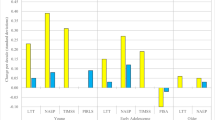Abstract
Regressing adjusted grade-point averages on freshman SAT scores and high school grade-point averages results in large increases in the incremental predictive validity of the SAT. Even so, the SAT still changes no more than a small proportion of admissions decisions and does not result in substantively important increases in freshman grades. The test does, however, change the composition of the freshman class by altering acceptances to some major areas of study and by limiting the access of women and blacks.
Similar content being viewed by others
References
Breland, H. (1985).An Examination of State University and College Admissions Policies (Research Report RR-85-3). Princeton, NJ: Educational Testing Service.
Bryk, A. S., and Raudenbush, S. W. (1992).Hierarchical Linear Models: Applications and Data Analysis Methods. Newbury Park, CA: Sage Publications.
Bryk, A. S., Raudenbush, S. W., Seltzer, M., and Congdon Jr., R. T. (1989).An Introduction to HLM: Computer Program and Users' Guide. Chicago, IL: Scientific Software, Inc.
Cameron, R. G. (1989).The Common Yardstick: A Case for the SAT. New York: College Entrance Examination Board.
Crouse, J., and Trusheim, D. (1988).The Case Against the SAT. Chicago: University of Chicago Press.
Crouse, J., and Trusheim, D. (1991). How colleges can correctly determine selection benefits from the SAT.Harvard Educational Review 61(2): 125–147.
Elliott, R., and Strenta, A. C. (1988). Effects of improving the reliability of the GPA on prediction generally and on comparative predictions for gender and race particularly.Journal of Educational Measurement 25(4): 333–347.
Goldman, R.D., and Hewitt, B. N. (1975). Adaptation level as an explanation for differential standards in college grading.Journal of Educational Measurement 12(3): 149–161.
Heckman, J. (1976). The common structure of statistical models of truncation, sample selection, and limited dependent variables and a sample estimator of such models.Annals of Economics and Social Measurement 5: 475–492.
Jensen, A. R. (1980).Bias in Mental Testing. New York: Free Press.
Nairn, A., and Associates (1980).The Reign of ETS: The Corporation That Makes Up Minds. Washington, DC: Ralph Nader.
Owen, D. (1985).None of the Above: Behind the Myth of Scholastic Aptitude. Boston: Houghton Mifflin.
Ramist, L., Lewis, C., and McCamley, L. (1990). Implications of using freshman GPA as the criterion for the predictive validity of the SAT. In W. Willingham, C. Lewis, R. Morgan, and L. Ramist (eds.),Predicting College Grades: An Analysis of Institutional Trends Over Two Decades. Princeton, NJ: Educational Testing Service.
Strenta, A. C., and Elliott, R. (1987). Differential grading standards revisited.Journal of Educational Measurement 24: 281–291.
Willingham, W., Lewis, C., Morgan, R., and Ramist, L. (eds.) (1990).Predicting College Grades: An Analysis of Institutional Trends Over Two Decades. Princeton, NJ: The College Board and Educational Testing Service.
Author information
Authors and Affiliations
Rights and permissions
About this article
Cite this article
Keller, D., Crouse, J. & Trusheim, D. The effects of college grade adjustments on the predictive validity and utility of SAT scores. Res High Educ 35, 195–208 (1994). https://doi.org/10.1007/BF02496701
Received:
Issue Date:
DOI: https://doi.org/10.1007/BF02496701




